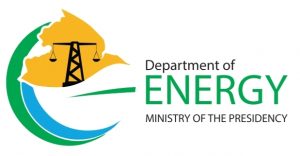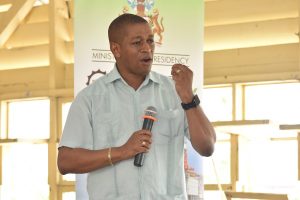PRESIDENT David Granger has termed Guyana’s next ten years as the ‘Decade of Development’. While our country’s traditional sectors will continue to grow and thrive, the ‘Decade of Development’ is largely owed to Guyana’s emerging oil sector, the revenues of which will fuel the country’s development for the next decade and beyond.
This edition of Government in Action is part one of a three-part series focusing on Guyana’s developing oil and gas sector.
A brief history
While Guyana’s oil and gas sector seems to be evolving quickly now, Guyana’s first discoveries of the black gold date back to the 1750s. According to a press release from Oil Now, the first petroliferous occurrences, or indications of oil in Guyana, were recorded by Dutch explorers.

However, drilling, by Nelson Cannon, for Guyana’s first exploration wells did not begin until the 1900s. Even then, Nelson Cannon drilled only in Waini, in 1916, and later on in the West Coast of Berbice, in 1926. The gas and pitch discovered there were used for domestic purposes.
The years passed and many companies from around the world expressed interest in petroleum exploration in Guyana, although many attempts ended with little success. This set this stage for American oil giant, Esso Exploration and Production Guyana Limited’s (ExxonMobil) oil and gas exploration in Guyana in 2008, leading to its US$460M world-class Liza discovery in 2015.
The petroleum potential of the Guyana-Suriname basin continues to baffle industry professionals today. The estimated 13.6 billion barrels of oil and 32 trillion cubic feet of natural gas truly redefines ‘Guyana El Dorado’.
First oil 2020
In his address to Parliament on October 18, 2018, President Granger outlined the mandate for the Department of Energy, which is tasked with managing the country’s petroleum sector.

“Your Government is developing the capability to effectively manage the oil and gas sector. We established, on the 1st August 2018, a Department of Energy to ensure that a sound organisational, administrative, legislative and regulatory framework would be put in place for the management of the sector in accordance with international best practice. The ‘Department’, whose remit includes renewable energy has commenced its work,” the Head of State said.
The President added that the Government is committed to the prudent management of Guyana’s oil and gas revenues. This, he said, is for the betterment of future generations of Guyanese.
“Oil production is expected to begin in 2020 and will be the most transformative economic development in our recent history. Your Government is taking steps to ensure that the revenues which accrue from the sector will not be squandered but, instead, will be invested strategically in building human and institutional capacity, addressing our infrastructural deficit and providing economic security for future generations,” he said.
The Department of Energy
Dr. Mark Bynoe, Director of the Department of Energy, has, for the past year, committed himself to the transparent management of the Department. Under his stewardship, the Department has conducted several outreaches across Guyana to help Guyanese gain knowledge about the emerging industry.
“The Department’s vision is to optimise the value proposition from the hydrocarbon sector in the Cooperative Republic [of Guyana] to allow the country to transition to cleaner, more affordable and reliable energy provisions and a sustainable development pathway… What we are expected to do is to manage the sector in a manner no different from what should be happening in Forestry or Mining, or the water sector, or any other… the benefits that are derived therefrom can be used for the betterment of all Guyana and Guyanese,” Dr. Bynoe said.
Although Guyana has had a long history with oil and gas, the Government of Guyana is still relatively new to the management of this sector. Shortly after establishment, the Department of Energy hired Oil and Gas Adviser, Matthew Wilks to help inform its evidence-based decision making.
Local Content
One major public concern the Department has addressed is the importance of a thorough Local Content Policy. Local Content, in this instance, refers to the development of a local workforce that is educated and equipped to confidently function within the oil and gas sector. This particular policy ensures that, while the industry is dominated by foreign oil exploration companies, Guyanese will still be an integral part of Guyana’s oil production.

“[The] Local Content Policy final draft is completed and is to be presented… to the private sector and other relevant stakeholders. Presently, more than 1100 Guyanese are working with [Esso Exploration and Production Guyana Limited (EEPGL)] and its subcontractors, representing approximately 50 per cent of the workforce within the industry,” Dr. Bynoe said.
The Energy Director added that “EEPGL is working with the Council for the Technical Vocational Education and Training on implementing two pilots to build capacity within the technical institutions. Furthermore, since 2015 over $119,000,000 have been spent by the EEPGL and its subcontractors on Guyanese contractors and service providers. The Department continues to seek to ensure that… the sector is managed in an effective and efficient manner and will spare no effort in ensuring that Guyanese are able to optimise the value from these resources.”
Production Sharing Agreements
A Production Sharing Agreement (PSA), in the hydrocarbon industry, refers to a contractual agreement between the Government of Guyana and an oil exploration company. This agreement governs the amount of extracted oil Guyana will receive from the companies.
The Department has created a best practice PSA template, which will be used to inform future negotiations. At a press conference held on July 29, 2019, Dr. Bynoe said the Department stands ready to review the best practice PSA template after a process of thorough consultation.
Thus far, the Government of Guyana has released the PSAs for Esso Exploration and Production Guyana Limited, CGX Energy, and Ratio Energy Limited.
Floating production storage and offloading unit

Tullow Oil and ExxonMobil have both made offshore oil discoveries, with Tullow recently making its first while Exxon has made a staggering 13 discoveries since 2015. With these massive oil finds, Guyana eagerly awaits the arrival of the first floating production storage and offloading (FPSO) unit, a vessel named Liza Destiny.
The FPSO is essentially a large ship capable of storing and processing crude hydrocarbons. First Lady, Mrs. Sandra Granger, in June of this year, commissioned the Liza Destiny before it set sail from Singapore. The FPSO is expected to arrive in Guyana’s waters by August month-end. Her arrival will mark a major milestone on the road to first oil.

“In preparation for first oil, as many of you would be aware, the naming ceremony of the Liza Destiny occurred on June 22nd in Singapore. The ship… [is] currently projected to arrive in Guyanese water in the first week of September of 2019. Now you would not that this is about two weeks ahead of initial projections and that’s because of the sea conditions, which are pretty favourable. In fact, the latest indications are that the ship had docked in South Africa to change crew and then to proceed on to Port Georgetown. On arrival, the operations will be to moor and anchor the vessel with off-shore hook-up and start-up of water projection lines, production umbilicals, and first oil still being anticipated in Q1 of 2020,” Dr. Bynoe said.
Guyanese, the time is now. In countries around the world, Guyana is quickly becoming known as ‘the place to be’. The Department of Energy and the Government of Guyana encourage you to get educated, get involved, and prime yourselves for the start of Guyana’s ‘Decade of Development’.




.png)









